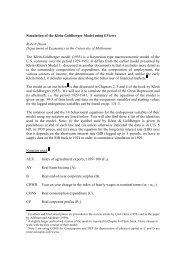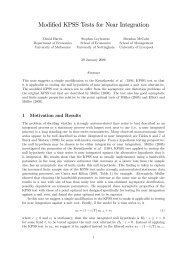Cobweb Theorems with production lags and price forecasting
Cobweb Theorems with production lags and price forecasting
Cobweb Theorems with production lags and price forecasting
Create successful ePaper yourself
Turn your PDF publications into a flip-book with our unique Google optimized e-Paper software.
In the classical cobweb model the solution to (1) is then<br />
Pt = (P0 − P ∗ �<br />
) − b1<br />
�t + P<br />
a1<br />
∗ , (2)<br />
where P ∗ is the equilibrium solution to (1), that is,<br />
P ∗ = − b1<br />
P<br />
a1<br />
∗ + a0 − b0<br />
a1<br />
The sequence defined in (2) converges to P ∗ if <strong>and</strong> only if b1 < a1. In words, the condition for<br />
convergence is that minus the slope of dem<strong>and</strong> as a function of <strong>price</strong> be larger than the slope of<br />
supply as a funtion of <strong>price</strong>. Usually, economic modelling assumes that the market is initially<br />
in equilibrium at P ∗ , <strong>and</strong> that an exogenous disturbance results in P0 �= P ∗ . An important<br />
question is whether such disturbances persist or die out; this can be answered by studying the<br />
conditions for convergence of Pt to P ∗ .<br />
We have in mind the <strong>price</strong>s of metals, for instance copper, which have greatly fluctuated <strong>and</strong><br />
shown some appearance of cycles over time. An important aspect of mining is the lag between<br />
the time the decision to increase or decrease <strong>production</strong> is made <strong>and</strong> the time the decision actually<br />
takes effect in the market. It takes several years for a planned new mine to start producing,<br />
<strong>and</strong> this has made some believe that the <strong>lags</strong> themselves may be a main cause of <strong>price</strong> fluctuations.<br />
In this paper, we study models that include <strong>production</strong> <strong>lags</strong> as well as <strong>price</strong> <strong>forecasting</strong>,<br />
the latter based on current <strong>and</strong> past <strong>price</strong>s. Stability means that <strong>price</strong>s converge to an equilibrium<br />
as time passes. R<strong>and</strong>om disturbances will also be included; in those models “stability”<br />
will mean that <strong>price</strong>s have a limit probability distribution (in other words that the <strong>price</strong> process<br />
has a stationary limit).<br />
Stability is not synonymous <strong>with</strong> absence of fluctuations, but it is a property of markets in which<br />
<strong>price</strong> fluctuations tend to dampen over time. By varying the parameters, one can get an idea of<br />
what may generate fluctuations. Is it <strong>production</strong> <strong>lags</strong>? Is it how <strong>price</strong>s are forecast? We look at<br />
those questions in the following sections.<br />
Given <strong>price</strong>s Pt, Pt−1, . . . , let ˆ Pt+ℓ be the <strong>price</strong> forecast used by producers to establish <strong>production</strong><br />
at time t + ℓ. (A more explicit notation would be ˆ Pt,t+ℓ, but we will use the simpler ˆ Pt+ℓ,<br />
as the lag ℓ will be fixed.) The classical cobweb theorem has a lag of one time unit.<br />
The market clearing condition is now<br />
This leads us to study the dynamical system<br />
.<br />
D(Pt+ℓ) = S( ˆ Pt+ℓ). (3)<br />
Pt+ℓ = D −1 ◦ S( ˆ Pt+ℓ). (4)<br />
Important questions are under what conditions this recursion has an equilibrium point, <strong>and</strong> if<br />
so whether Pt converges to it when t → ∞. Once again, such convergence does not exclude<br />
fluctuations, but it does say that perturbations are damped by the system over time.<br />
The classical description of the cobweb theorem (such as the one we gave above) assumes<br />
that the supply <strong>and</strong> dem<strong>and</strong> functions are linear. We will assume that the dem<strong>and</strong> <strong>and</strong> supply<br />
functions are respectively<br />
D(p) = p −d , S(p) = p s , d, s > 0. (5)<br />
One advantage of these functions is that <strong>price</strong> <strong>and</strong> <strong>production</strong> always remain positive, while<br />
linear functions may lead to negative <strong>price</strong>s (see (2)). Tractability is achieved by using the<br />
logarithm of <strong>price</strong>s, as will be shown below. It will be seen that a very important quantity is the<br />
ratio of the elasticities of supply <strong>and</strong> dem<strong>and</strong>, which we denote c = s/d.<br />
2







